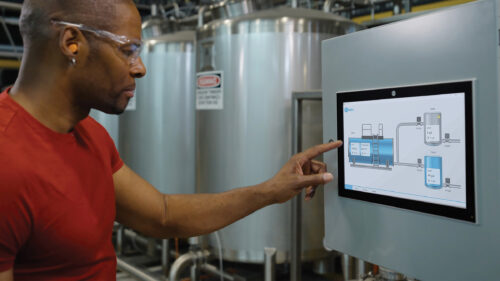Factory floor visualization
Soapbox: When it comes to sharing information, the factory floor has simply not kept pace with the rest of the business world. There have been vast improvements in HMIs (human machine interfaces) over the years, but the majority of HMI and SCADA (supervisory control and data acquisition) systems are standalone applications, and often manual processes.
When it comes to sharing information, the factory floor has simply not kept pace with the rest of the business world. There have been vast improvements in HMIs (human machine interfaces) over the years, but the majority of HMI and SCADA (supervisory control and data acquisition) systems are standalone applications, and often manual processes. This is in sharp contrast to the office environment, which has fully embraced data sharing technologies like e-mail, instant messaging, MRP/ERP systems, office productivity suites, and electronic project tracking.
Why the difference? It’s all about performance and stability. While various HMI packages offer Web access or Web publishing today, the underlying technologies of most of these do not meet the needs of the factory floor. Inadequate software performance slows data sharing and remote HMI use on the factory floor—but it doesn’t have to be that way.
The most straightforward way of publishing Web data is using standard HTML (hypertext markup language). This is the original language of the World Wide Web. While it works great for viewing static pages of data, it fails miserably when trying to view changing data or provide real-time control of a machine. The reason is that HTML is designed to be client-driven.
With HTML, the client browser is responsible for requesting new data, and there is no mechanism for the server to “push” new data to the client. To get real-time updates, the client must “poll” the server by requesting refreshes on a regular basis. Since this means resending an entire page of data, update frequency rates are severely limited. This makes it impractical for applications requiring instant alarm notification, real-time data monitoring, or interactive animations.
Another common option for remote monitoring and control is a class of technologies known as “screen scraping.” This is the approach taken by most remote HMI products. As the name implies, these technologies essentially scrape off the image on the server’s screen and transfer it to the client. The client machine then displays the server’s screen image, and transfers its own user input to the server. This lets the operator interact with the machine as if he or she were in front of it.
Screen scraping is used in many of today’s “Web published” HMIs and, while it does allow for remote access, it is not real-time and performance is a problem. Because so much data are being transferred, screen scraping requires high-speed connections, and it severely limits the number of clients.
Another common approach is to create a custom browser plug-in that is responsible for communicating with the server and transferring information to a remote thin client. If the program is designed well, this approach can solve the bandwidth problem by eliminating the need to poll for data and transferring only information that has changed. This approach also can allow remote operators to view different screens than what the server shows. In practice, however, these solutions are often overly complicated to set up and administer. They also require installing custom, and usually expensive, applications on every client system.
Off-the-shelf browser technologies such as Adobe Flash can solve these issues. More than 98% of all desktop Web browsers already have Adobe Flash installed on their systems (avoiding custom plug-in hassles), and Flash’s installed base ensures wide acceptance.
We decided to use Flash in our Interact Xpress and Parker Factory Display product lines to provide for a rich Internet experience through standard Web browsers. Flash provides all the advantages of a custom plug-in without the associated costs and hassles. And, it lets users get the “information anywhere” capabilities of remote Web access at about the same cost as a standalone HMI product.
With the capabilities of Flash technology, a Web browser can be embedded on a SCADA operator panel, thereby avoiding duplication of client HMI applications. In our estimation, up to 80% of the screens on a typical SCADA package already exist on the machine. Why duplicate them? This also means that Andon information is no longer restricted to the factory floor. Since the data are Web published, screens can be seen from any laptop or personal digital assistant anywhere in the world. All that is required is the proper security clearance, a network connection, and a Flash player-enabled browser.
| Author Information |
| Andy Balderson is a product sales manager and Brent Meranda is an HMI software engineering manager with Parker’s Electromechanical Automation Division. |
Do you have experience and expertise with the topics mentioned in this content? You should consider contributing to our CFE Media editorial team and getting the recognition you and your company deserve. Click here to start this process.





